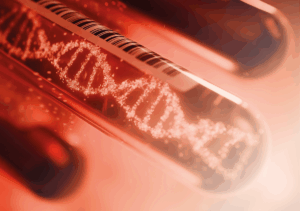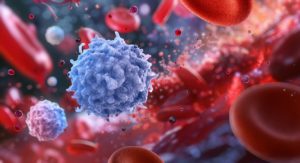This month’s paper is interested in the genetic characteristics of two types of acute blood cancer: AML (Acute Myeloid Leukemia, most common leukemia in adults) and T-ALL (T-cell Acute Lymphoblastic Leukemia, most common cancer in children). The research team combined genomic analysis of leukemic cells with screening of blood samples from patients to assess differences in gene expression between these two close but different diseases.
They first analyzed publicly available acute leukemia datasets to look for Differentially Expressed Genes (DEGs) between AML and T-ALL. They isolated 172 genes shared by all datasets with significant up or downregulated expression. Those genes appeared to be linked to cellular pathways related to immune functions and collagen and extracellular matrix decomposition. Upon the most important variations, genes such as LAT (linker for activation of T cells, a transmembrane protein involved in the transduction pathway of T-cells activation) and ITK (IL-2-induced T cell kinase, a gene involved in T-cells proliferation and differentiation) were overexpressed in ALL. Overexpressed in AML are TLR4 (a cell surface receptor of the innate immune system) and MPO (an enzyme producing reactive oxygen species to destroy bacteria). Knowledge of these impacted pathways is important to offer possible medical angles of attack against leukemia.
To validate these results, the T-ALL and AML patients’ blood are analysed using a technique called Raman spectroscopy, in which light is scattered by the blood components (collagen, proteins, nucleic acids) respectively to their molecular structure. Peak intensities in the resultant Raman plots enable us to compare physiological differences between the two leukemia types. For example, intensity peaks corresponding to nucleic acids and proteins are higher in AML than T-ALL. From a pathological point of view, Liang and his colleagues explain that the high rates of metabolic activity documented in the bone marrow of T-ALL patients is likely to cause the lack of proteins (and their building blocks amino acids) observed in the rest of the blood system by this spectroscopy experiment.
More generally the spectroscopic method enables deciphering subtle variations in the patients’ blood that are not so visible with standard biochemical analyses.
All in all, this experiment used both bioinformatics to detect differentially expressed genes in leukemia (that might be targeted by novel and/or combined therapeutics) and spectrometry to validate those results in the clinic at the physiological level. Spectrometry also enables a closer look at pathological differences in patients’ blood and highlights reliable biomarkers in AML and T-ALL diagnosis.
Bridging the gap between broad genomic datasets and analysis of blood components, our HEMATO pro kit screens for genomic variants in 137 genes associated with lymphoid and myeloid diseases. Discover more at 4bases.ch/hemato-pro
Liang H, Kong X, Cao Z, Wang H, Liu E, Sun F, Qi J, Zhang Q and Zhou Y (2023) Bioinformatics and Raman spectroscopy-based identification of key pathways and genes enabling differentiation between acute myeloid leukemia and T cell acute lymphoblastic leukemia. Front. Immunol. 14:1194353. doi: 10.3389/fimmu.2023.1194353





